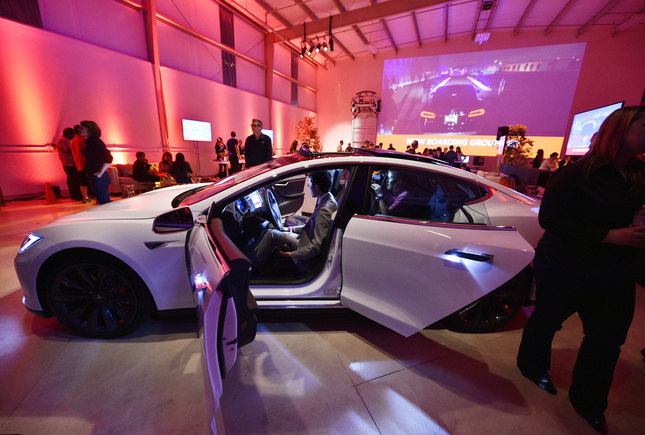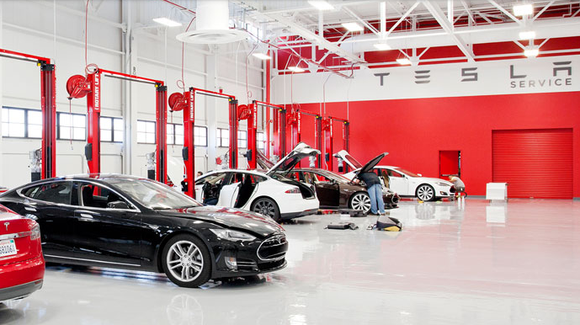News
How Tesla Challenges Other Car Makers
Tesla challenges other car makers to build better cars says Diarmuid O’Connell, Telsa’s vice president of business development at an industry conference.

Diarmuid O’Connell, Tesla’s VP of business development, had harsh words for competitors last week at the CAR management briefing seminars in Michigan. He told the group that Tesla challenges other car makers to build better cars.
“You can split the market of EVs into two programs,” he said. “Many are compliance programs. Exceptions are Nissan, ourselves and BMW. Most are focused on minimum compliance, lowest common denominator behavior, and the vehicles reflect that. In some respect, they are appliances, in terms of the way they look.”
CARB And The EPA
His remarks come at a time when two important regulatory programs are up for review. The California Air Resources Board is taking a look at its zero emissions vehicle policies and the Environmental Protection Agency is considering changes to its CAFE standards.
Traditional car makers are trying to get both agencies to relax those standards, but O’Connell says they should stop trying to “slow walk” the rate of progress toward a emissions free future and get busy building better cars. He says his company wants California and the EPA to raise their standards, not relax them.
“From an empirical standpoint, the [regulations] are very weak, eminently achievable and the only thing missing is the will to put compelling products on the road,” he said, according to The Wall Street Journal.
This week, Mary Nichols, CARB chairwoman since 2007, announced that she isn’t satisfied with having just a few electric cars on California roads. The current standard calls for 2.7% of all cars sold in California to be electric. Nichols wants to set the bar higher. In fact, she would like it if all the cars sold in California were electric by 2030.
For its part, the automotive industry is busy telling the EPA that the current CAFE standards are too high. Any further tightening would be bad for business. “We need consumers to buy them in high volumes to meet the steep climb in fuel economy standards ahead,” the Alliance of Automobile Manufacturers, an industry lobbying group, told the conference. The implication is that higher standards will kill the automotive business, cause massive layoffs, and have a negative impact on the economy.
This is precisely the same argument the automobile industry made about safety related changes in the ’50’s, seat belts in the 60’s, exhaust emission in the 70’s, airbags in the 90’s and better crash test performance at the beginning of the 21st century. Its complaints today are just more of the same.
CAFE Olay
The furor over EPA standards is actually a tempest in a teapot. On the surface of it, the 54.5 mpg requirement by 2025 seems like a huge increase above present day performance. But in reality, that standard is based on the old EPA mileage testing protocol, which was amended several years ago because it resulted in numbers that were wildly optimistic.
When the EPA adopted a new standard designed to better reflect real world expectations, it did not apply the new standard to the computation of the 2025 goal. If it did, that 54.5 mpg number would convert to around 37 mpg — which many of today’s cars are already capable of achieving.
To suggest that car companies cannot achieve a CAFE of 37 mpg using the current EPA protocol is patently absurd. In fact, a representative of Johnson Controls, one of the largest suppliers of components to the automobile manufacturing , said last year that car makers can easily meet the new standard and, in fact, many are already doing so today with internal combustion cars.
Charging Technology
One area where other manufacturers need to step up involves recharging technology for EVs and plug-in cars. At present, the best any of those other cars can handle is 50 kW. Tesla already has Superchargers with more than double that capacity. It’s new liquid cooled charging cables indicate the company has even higher power chargers in mind for the future.
O’Connell told the conference that drivers of competitors’ cars would be welcome to use the Supercharger network if only their cars were capable of handling the higher current. Tesla made its Supercharger patents public last year, but no other manufacturer has expressed any interest in them. Instead, the industry seems content to live with 50 kW “fast chargers” that really aren’t all that fast.
The Week In Review
Tesla has had a rough week. The stock market was disappointed with what Elon Musk had to say during the 2nd quarter conference call and punished the company’s stock, which closed down nearly 9% for the week.
The real question on people’s minds is whether Tesla will bring electric cars to the masses the way the Model T put the world on wheels almost a century ago, or whether it is a company that caters only to the wealthy and will flame out the way the Concorde SST did? If you are reading this, chances are we know how you would answer that question.

Elon Musk
Starlink passes 9 million active customers just weeks after hitting 8 million
The milestone highlights the accelerating growth of Starlink, which has now been adding over 20,000 new users per day.

SpaceX’s Starlink satellite internet service has continued its rapid global expansion, surpassing 9 million active customers just weeks after crossing the 8 million mark.
The milestone highlights the accelerating growth of Starlink, which has now been adding over 20,000 new users per day.
9 million customers
In a post on X, SpaceX stated that Starlink now serves over 9 million active users across 155 countries, territories, and markets. The company reached 8 million customers in early November, meaning it added roughly 1 million subscribers in under seven weeks, or about 21,275 new users on average per day.
“Starlink is connecting more than 9M active customers with high-speed internet across 155 countries, territories, and many other markets,” Starlink wrote in a post on its official X account. SpaceX President Gwynne Shotwell also celebrated the milestone on X. “A huge thank you to all of our customers and congrats to the Starlink team for such an incredible product,” she wrote.
That growth rate reflects both rising demand for broadband in underserved regions and Starlink’s expanding satellite constellation, which now includes more than 9,000 low-Earth-orbit satellites designed to deliver high-speed, low-latency internet worldwide.
Starlink’s momentum
Starlink’s momentum has been building up. SpaceX reported 4.6 million Starlink customers in December 2024, followed by 7 million by August 2025, and 8 million customers in November. Independent data also suggests Starlink usage is rising sharply, with Cloudflare reporting that global web traffic from Starlink users more than doubled in 2025, as noted in an Insider report.
Starlink’s momentum is increasingly tied to SpaceX’s broader financial outlook. Elon Musk has said the satellite network is “by far” the company’s largest revenue driver, and reports suggest SpaceX may be positioning itself for an initial public offering as soon as next year, with valuations estimated as high as $1.5 trillion. Musk has also suggested in the past that Starlink could have its own IPO in the future.
News
NVIDIA Director of Robotics: Tesla FSD v14 is the first AI to pass the “Physical Turing Test”
After testing FSD v14, Fan stated that his experience with FSD felt magical at first, but it soon started to feel like a routine.

NVIDIA Director of Robotics Jim Fan has praised Tesla’s Full Self-Driving (Supervised) v14 as the first AI to pass what he described as a “Physical Turing Test.”
After testing FSD v14, Fan stated that his experience with FSD felt magical at first, but it soon started to feel like a routine. And just like smartphones today, removing it now would “actively hurt.”
Jim Fan’s hands-on FSD v14 impressions
Fan, a leading researcher in embodied AI who is currently solving Physical AI at NVIDIA and spearheading the company’s Project GR00T initiative, noted that he actually was late to the Tesla game. He was, however, one of the first to try out FSD v14.
“I was very late to own a Tesla but among the earliest to try out FSD v14. It’s perhaps the first time I experience an AI that passes the Physical Turing Test: after a long day at work, you press a button, lay back, and couldn’t tell if a neural net or a human drove you home,” Fan wrote in a post on X.
Fan added: “Despite knowing exactly how robot learning works, I still find it magical watching the steering wheel turn by itself. First it feels surreal, next it becomes routine. Then, like the smartphone, taking it away actively hurts. This is how humanity gets rewired and glued to god-like technologies.”
The Physical Turing Test
The original Turing Test was conceived by Alan Turing in 1950, and it was aimed at determining if a machine could exhibit behavior that is equivalent to or indistinguishable from a human. By focusing on text-based conversations, the original Turing Test set a high bar for natural language processing and machine learning.
This test has been passed by today’s large language models. However, the capability to converse in a humanlike manner is a completely different challenge from performing real-world problem-solving or physical interactions. Thus, Fan introduced the Physical Turing Test, which challenges AI systems to demonstrate intelligence through physical actions.
Based on Fan’s comments, Tesla has demonstrated these intelligent physical actions with FSD v14. Elon Musk agreed with the NVIDIA executive, stating in a post on X that with FSD v14, “you can sense the sentience maturing.” Musk also praised Tesla AI, calling it the best “real-world AI” today.
News
Tesla AI team burns the Christmas midnight oil by releasing FSD v14.2.2.1
The update was released just a day after FSD v14.2.2 started rolling out to customers.

Tesla is burning the midnight oil this Christmas, with the Tesla AI team quietly rolling out Full Self-Driving (Supervised) v14.2.2.1 just a day after FSD v14.2.2 started rolling out to customers.
Tesla owner shares insights on FSD v14.2.2.1
Longtime Tesla owner and FSD tester @BLKMDL3 shared some insights following several drives with FSD v14.2.2.1 in rainy Los Angeles conditions with standing water and faded lane lines. He reported zero steering hesitation or stutter, confident lane changes, and maneuvers executed with precision that evoked the performance of Tesla’s driverless Robotaxis in Austin.
Parking performance impressed, with most spots nailed perfectly, including tight, sharp turns, in single attempts without shaky steering. One minor offset happened only due to another vehicle that was parked over the line, which FSD accommodated by a few extra inches. In rain that typically erases road markings, FSD visualized lanes and turn lines better than humans, positioning itself flawlessly when entering new streets as well.
“Took it up a dark, wet, and twisty canyon road up and down the hill tonight and it went very well as to be expected. Stayed centered in the lane, kept speed well and gives a confidence inspiring steering feel where it handles these curvy roads better than the majority of human drivers,” the Tesla owner wrote in a post on X.
Tesla’s FSD v14.2.2 update
Just a day before FSD v14.2.2.1’s release, Tesla rolled out FSD v14.2.2, which was focused on smoother real-world performance, better obstacle awareness, and precise end-of-trip routing. According to the update’s release notes, FSD v14.2.2 upgrades the vision encoder neural network with higher resolution features, enhancing detection of emergency vehicles, road obstacles, and human gestures.
New Arrival Options also allowed users to select preferred drop-off styles, such as Parking Lot, Street, Driveway, Parking Garage, or Curbside, with the navigation pin automatically adjusting to the ideal spot. Other refinements include pulling over for emergency vehicles, real-time vision-based detours for blocked roads, improved gate and debris handling, and Speed Profiles for customized driving styles.









